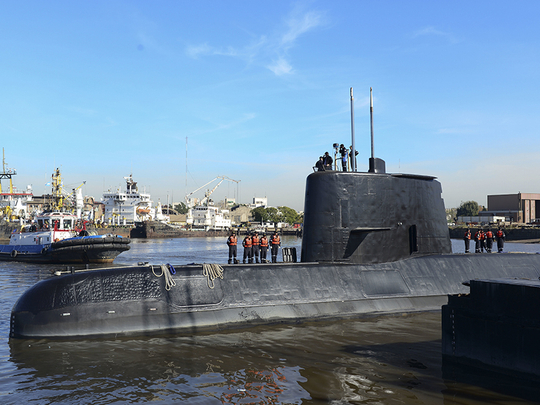
MAR DEL PLATA, Argentina: An international search mission for a missing Argentine submarine entered a critical phase Tuesday after nearly a week without signs of life — as the vessel risked running out of oxygen after being submerged for so long.
The ARA San Juan would have enough oxygen for its crew to survive underwater for seven days, if there was no hull breach, according to officials. At 0730 GMT Wednesday, that time will have elapsed.
“The question of oxygen has worried us since the beginning,” admitted navy spokesman Enrique Balbi.
“Little by little we enter an increasingly critical phase.”
The vessel, which has 44 crew members, made its last contact with authorities to report a mechanical breakdown, but, as storm conditions which had impeded rescuers eased, officials said they were not ceding to despair yet.
“We haven’t discarded any hypothesis. Assuming the most critical phase, which would be the submarine is submerged and cannot surface, we are in the 6th day of oxygen,” Enrique Balbi told a news conference in Buenos Aires earlier Tuesday.
“As a submariner, I am not losing hope,” he said.
The 34-year-old German-built diesel-electric submarine that was refitted between 2007 and 2014 had flagged a breakdown in its batteries and said it was diverting its route from the far south of Argentina’s Atlantic waters to the navy base at Mar del Plata, where most of the crew members live.
It didn’t issue a distress call, however. It was unclear if the problem ended leaving the vessel without propulsion or unable to surface.
The search began November 16, when there was no more contact.
National apprehension
The sub’s disappearance has gripped the nation, and President Mauricio Macri visited the relatives — troubled by earlier false hopes — and prayed with them.
Underwater sounds were determined to originate from a sea creature, not the vessel.
Satellite signals were also determined to be false alarms.
Argentina is leading an air-and-sea search with help from nine countries, including Brazil, Britain, Chile, Colombia, France, Germany, Peru, the United States and Uruguay.
Poor weather in the South Atlantic had badly hampered the operation in the past few days, with strong winds and waves that had towered as high as six meters (20 feet).
But conditions improved Tuesday.
“Luckily, wind intensity has started to drop, and waves are three to four meters, which should allow a three-dimensional sweep of the (sea) floor,” Balbi said.
The initial search zone was already large, with a diameter of 300 kilometres (200 miles) and a depth of up to 350 meters (1,200 feet).
But it could be expanded sevenfold, according to the defence ministry.
‘They will come back’
The incident has recalled recent submarine disasters, perhaps most prominently that of the Kursk, a Russian nuclear sub that caught fire and exploded underwater in 2000, killing all 118 on board — some instantly, others over days.
There was also a Chinese sub accident in 2003 that killed 70 crew, apparently suffocated after what Beijing termed “mechanical problems.”
Among the ARA San Juan’s crew is Argentina’s first female navy submariner: Eliana Krawczyk, 35.
Cards, banners with slogans and placards have been strung up on the outside of the Mar del Plata base’s wire fence, expressing solidarity with the families tensely waiting for any news.
“There’s a mix of feelings: pain, helplessness, at times hope,” Maria Morales said. “The feeling is that they will come back, that we will tell us today, ‘They are back.’”
– AFP












